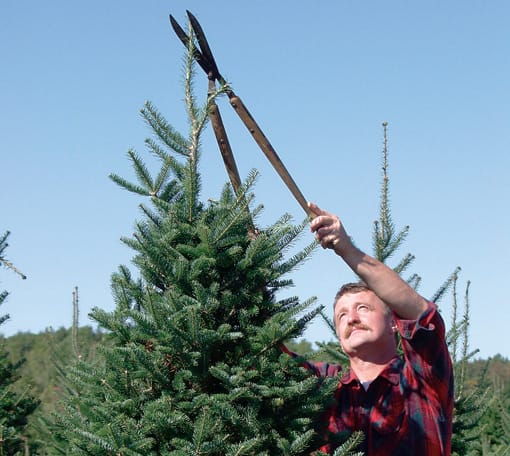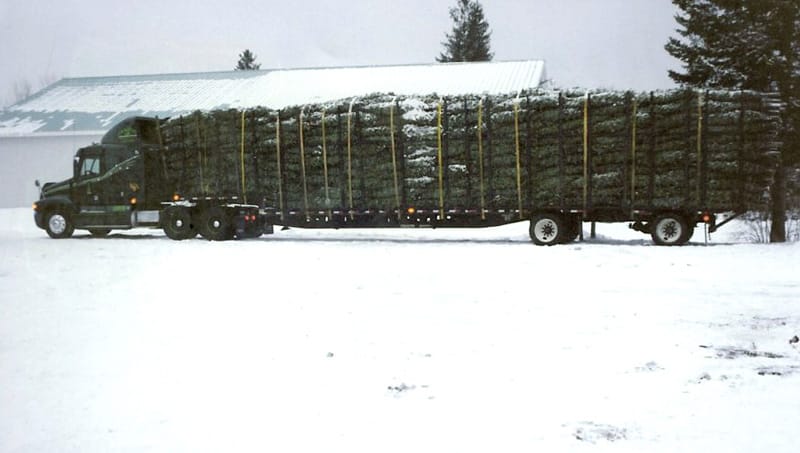A family farm, a year-round commitment.
November and December are hectic months. We all know that. We stop worrying about gardens long reduced to frost-bitten compost and try to forget that winter snow will soon cover the scenery. There are trips to local malls and shops to find gifts for family and friends. There are houses to decorate, cards to write, holiday treats to bake and happy times to anticipate. A list is drawn up to keep us on track. At the top of that list is the acquisition of a Christmas tree. It can't be just any Christmas tree either; it must be the perfect tree. Not too tall, but tall enough to fill the designated space. Not too skinny-merely thick enough to hold the collection of ornaments and strings of lights. Almost magically, Christmas tree lots appear in grocery store parking facilities and vacant areas, offering for sale natural trees of all descriptions. Where do all these trees come from, and how are these perfect trees grown?
Mike Keddy and Janet Larder own the Keddy Christmas Tree Company, and are well able to answer the questions. Sitting comfortably on their screened deck in New Ross, NS, last summer, the Christmas season seemed far away. Rose blossoms, young chicks and fresh strawberries were the order of the day. However, Christmas tree production was never far from their minds or the conversation. "We were both born into the business," Mike noted. "I suppose our history is the history of the industry. We grew up in an area where people cut naturally growing trees in the fall to make extra money. It paid the taxes and gave them a Christmas. Two thousand dollars made a big difference in households back then. I would get off the school bus with my brothers even at seven or eight years of age and we would run back to the tree lot and drag trees out to the road. It was something you did as part of your family."

Both Mike and Janet pursued other occupations. Mike worked on the oilrigs, and Janet ran a restaurant, but in time they were drawn back to the tree business full time. Mike bought out his two uncles' business in 1975 and hasn't looked back. "The industry has changed. In the past customers went out and cut their own trees on Crown land or on the side of the road. Now trees are grown for the marketplace. It is no longer a sideline. This is how we earn our living." The Keddy family has 200 acres planted. This produces an average of 100 Balsam fir trees per acre for the annual harvest. Throughout the year, they monitor the new trees, ensuring that natural regeneration is occurring. They, prune seedlings, shear and shape the more mature trees. Finally, the end of October comes and harvesting begins. On average 13,000 to 15,000 trees are cut, bundled and shipped, mostly to the United States. It has cost $6 to 7 to grow a tree not accounting for the price of the land.
Admittedly, not all trees are equal. The trees must be graded for their size, thickness and faults. "Everybody wants the perfect tree, but perfection is different for everybody," Mike explained. He related the story of his father and a neighbour who both claimed they admired each other's trees-one short and thick called a butterball tree, one tall and sparsely branched more in the German tradition. Then both men returned home shaking their heads at the other's folly. To each his own.
Ross Pentz, Western Nova Scotia Christmas Tree Specialist with the provincial Department of Natural Resources, shed light on the wider industry. The birth of the industry probably stemmed from the first shipment of trees to the United States in 1915, he says. Since the tradition of using an evergreen tree as a Christmas custom was catching on, shippers needed a reliable source. (The tradition had gained popularity when the Illustrated London Times featured a picture of Queen Victoria, Prince Albert and their children around a tree in 1846. The English royal family's predominantly German traditions hit a cord with the public. The English-speaking world adopted the tree as a symbol of Christmas hopefulness.)
 In the Maritimes, people followed the trend, and, when possible, joined in the business of supplying the trees to large American wholesalers. "By the 1960s due to the demand for higher quality of trees, it became a business," Ross explained. "The industry is worth $30 million per year in Nova Scotia with two million trees and a quarter million wreaths exported. There are 2,500 growers (500 are full time) in Nova Scotia alone with 35,000 acres in production. New Brunswick produces one million trees and half a million wreaths. Ninety five per cent of these trees and wreaths go to the States, Puerto Rico, Panama, Japan and Mexico."
In the Maritimes, people followed the trend, and, when possible, joined in the business of supplying the trees to large American wholesalers. "By the 1960s due to the demand for higher quality of trees, it became a business," Ross explained. "The industry is worth $30 million per year in Nova Scotia with two million trees and a quarter million wreaths exported. There are 2,500 growers (500 are full time) in Nova Scotia alone with 35,000 acres in production. New Brunswick produces one million trees and half a million wreaths. Ninety five per cent of these trees and wreaths go to the States, Puerto Rico, Panama, Japan and Mexico."
It is interesting to note that 99 per cent of the trees grown are Balsam fir. Their thick branches hold decorations well and these trees keep their needles, important considerations in producing the perfect tree. Since it takes only 10 to12 years to grow a Balsam fir under the almost ideal Maritime conditions, growers can plan for their future harvests.
In fact, a few of the best specimens are given away. The people of New Brunswick annually send an immense tree to Boston in thanks for generously helping Saint John during the 1877 fire that destroyed the city. In a similar manner, Ross Pentz helps Nova Scotians select a 50-foot tree each year that is sent again to Boston. This tree stands proudly during the holiday season in front of the Prudential Center as thanks for Boston's response to the devastation of the 1917 Halifax Explosion. Ross notes "the tree lighting ceremony is spectacular and since September 11th the tradition has brought the communities even closer together."
Ross spoke of the Christmas tree growers' way of life enthusiastically. "Not everybody would live this life. It is sometimes difficult. Harvest time in particular is gruelling." Even a cursory reading of the industry newsletter, the Nova Scotia Christmas Tree Journal, reveals challenges in the industry. Competition increases, pests attack the young trees, markets change, new products are introduced, equipment costs escalate, and legislation threatens to reduce the size of some lots. "And yet, growers are proud of their trees and their rural way of life," Ross noted.
And what about the five per cent of trees which aren't exported? These are the wonderful trees Maritimers find in lots, balancing against stands waiting to be unbundled, transported home, decorated and made the centrepiece of family holiday traditions. As Janet Larder concluded, "We will grow Christmas trees until we die. It is a wonderful life for our family and we get to share traditions with other people, some whom we meet at our lot in Bedford. The customer takes the tree home and it will be the centre of their Christmas. How could life be better?"
For more information on Christmas trees see:
The Canadian Christmas Tree Growers Association Web site
Provincial government Web sites often feature information on selection, care and disposal of Christmas trees during the holiday season. Check your local government site:
www.gov.pe.ca
www.gov.ns.ca
www.gov.nb.ca
www.gov.nf.ca
